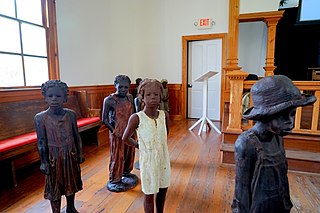
The Act Prohibiting Importation of Slaves of 1807 is a United States federal law that prohibited the importation of slaves into the United States. It took effect on January 1, 1808, the earliest date permitted by the United States Constitution.

The institution of slavery in the European colonies in North America, which eventually became part of the United States of America, developed due to a combination of factors. Primarily, the labor demands for establishing and maintaining European colonies resulted in the Atlantic slave trade. Slavery existed in every European colony in the Americas during the early modern period, and both Africans and indigenous peoples were targets of enslavement by Europeans during the era.

The legal institution of human chattel slavery, comprising the enslavement primarily of Africans and African Americans, was prevalent in the United States of America from its founding in 1776 until 1865, predominantly in the South. Slavery was established throughout European colonization in the Americas. From 1526, during the early colonial period, it was practiced in what became Britain's colonies, including the Thirteen Colonies that formed the United States. Under the law, an enslaved person was treated as property that could be bought, sold, or given away. Slavery, except as a punishment for crime, lasted in about half of U.S. states until abolition in 1865, and issues concerning slavery seeped into every aspect of national politics, economics, and social custom. In the decades after the end of Reconstruction in 1877, many of slavery's economic and social functions were continued through segregation, sharecropping, and convict leasing. Slavery as a punishment for crime is still legal in the United States.

In the United States before 1865, a slave state was a state in which slavery and the internal or domestic slave trade were legal, while a free state was one in which they were prohibited. Between 1812 and 1850, it was considered by the slave states to be politically imperative that the number of free states not exceed the number of slave states, so new states were admitted in slave–free pairs. There were, nonetheless, some slaves in most free states up to the 1840 census, and the Fugitive Slave Clause of the U.S. Constitution, as implemented by the Fugitive Slave Act of 1793 and the Fugitive Slave Act of 1850, provided that a slave did not become free by entering a free state and must be returned to their owner. Enforcement of these laws became one of the controversies which arose between slave and free states.

The slave codes were laws relating to slavery and enslaved people, specifically regarding the Atlantic slave trade and chattel slavery in the Americas.

In the context of the history of slavery in the Americas, free people of color were primarily people of mixed African, European, and Native American descent who were not enslaved. However, the term also applied to people born free who were primarily of black African descent with little mixture. They were a distinct group of free people of color in the French colonies, including Louisiana and in settlements on Caribbean islands, such as Saint-Domingue (Haiti), St. Lucia, Dominica, Guadeloupe, and Martinique. In these territories and major cities, particularly New Orleans, and those cities held by the Spanish, a substantial third class of primarily mixed-race, free people developed. These colonial societies classified mixed-race people in a variety of ways, generally related to visible features and to the proportion of African ancestry. Racial classifications were numerous in Latin America.

The Blockade of Africa began in 1808 after the United Kingdom outlawed the Atlantic slave trade, making it illegal for British ships to transport slaves. The Royal Navy immediately established a presence off Africa to enforce the ban, called the West Africa Squadron. Although the ban initially applied only to British ships, Britain negotiated treaties with other countries to give the Royal Navy the right to intercept and search their ships for slaves.
Antebellum South Carolina is typically defined by historians as South Carolina during the period between the War of 1812, which ended in 1815, and the American Civil War, which began in 1861.

Wanderer was the penultimate documented ship to bring an illegal cargo of enslaved people from Africa to the United States, landing at Jekyll Island, Georgia, on November 28, 1858. It was the last to carry a large cargo, arriving with some 400 people. Clotilda, which transported 110 people from Dahomey in 1860, is the last known ship to bring enslaved people from Africa to the US.

The internal slave trade in the United States, also known as the domestic slave trade, the Second Middle Passage and the interregional slave trade, was the mercantile trade of enslaved people within the United States. It was most significant after 1808, when the importation of slaves from Africa was prohibited by federal law. Historians estimate that upwards of one million slaves were forcibly relocated from the Upper South, places like Maryland, Virginia, Kentucky, North Carolina, Tennessee, and Missouri, to the territories and then-new states of the Deep South, especially Georgia, Alabama, Louisiana, Mississippi, and Arkansas.

Partus sequitur ventrem was a legal doctrine passed in colonial Virginia in 1662 and other English crown colonies in the Americas which defined the legal status of children born there; the doctrine mandated that children of enslaved mothers would inherit the legal status of their mothers. As such, children of enslaved women would be born into slavery. The legal doctrine of partus sequitur ventrem was derived from Roman civil law, specifically the portions concerning slavery and personal property (chattels), as well as the common law of personal property; analogous legislation existed in other civilizations including Medieval Egypt in Africa and Korea in Asia.

Gwendolyn Midlo Hall was an American historian who focused on the history of slavery in the Caribbean, Latin America, Louisiana, Africa, and the African Diaspora in the Americas. Discovering extensive French and Spanish colonial documents related to the slave trade in Louisiana, she wrote Africans in Colonial Louisiana: The Development of Afro-Creole Culture in the Eighteenth Century (1992), studied the ethnic origins of enslaved Africans brought to Louisiana, as well as the process of creolization, which created new cultures. She changed the way in which several related disciplines are researched and taught, adding to scholarly understanding of the diverse origins of cultures throughout the Americas.

Slavery in Virginia began with the capture and enslavement of Native Americans during the early days of the English Colony of Virginia and through the late eighteenth century. They primarily worked in tobacco fields. Africans were first brought to colonial Virginia in 1619, when 20 Africans from present-day Angola arrived in Virginia aboard the ship The White Lion.

Freedom suits were lawsuits in the Thirteen Colonies and the United States filed by slaves against slaveholders to assert claims to freedom, often based on descent from a free maternal ancestor, or time held as a resident in a free state or territory.

In the United States, abolitionism, the movement that sought to end slavery in the country, was active from the colonial era until the American Civil War, the end of which brought about the abolition of American slavery, except as punishment for a crime, through the Thirteenth Amendment to the United States Constitution.

Slavery in Cuba was a portion of the larger Atlantic slave trade that primarily supported Spanish plantation owners engaged in the sugarcane trade. It was practiced on the island of Cuba from the 16th century until it was abolished by Spanish royal decree on October 7, 1886.

Monroe Edwards was an American slave trader, forger, and criminal who was the subject of a well-publicized trial and conviction in 1842. Originally from Kentucky, Edwards moved to New Orleans then settled in Texas. He smuggled slaves into Brazil in 1832 and used the proceeds to purchase land in Texas. In 1836, he was again smuggling slaves, this time into Texas. After attempting to swindle his partner out of the profits of the venture, partly with forged documents, Edwards was forced to flee the Republic of Texas to the United States. He then tried to scam money out of various abolitionists in the United States and the United Kingdom, partly with forged letters of introduction. He traveled to the United Kingdom, but his schemes were mainly unsuccessful and he returned to the United States in mid-1841.

Following Robert Cavelier de La Salle establishing the French claim to the territory and the introduction of the name Louisiana, the first settlements in the southernmost portion of Louisiana were developed at present-day Biloxi (1699), Mobile (1702), Natchitoches (1714), and New Orleans (1718). Slavery was then established by European colonists.

Slavery was legally practiced in the Province of North Carolina and the state of North Carolina until January 1, 1863, when President Abraham Lincoln issued the Emancipation Proclamation. Prior to statehood, there were 41,000 enslaved African-Americans in the Province of North Carolina in 1767. By 1860, the number of slaves in the state of North Carolina was 331,059, about one third of the total population of the state. In 1860, there were nineteen counties in North Carolina where the number of slaves was larger than the free white population. During the antebellum period the state of North Carolina passed several laws to protect the rights of slave owners while disenfranchising the rights of slaves. There was a constant fear amongst white slave owners in North Carolina of slave revolts from the time of the American Revolution. Despite their circumstances, some North Carolina slaves and freed slaves distinguished themselves as artisans, soldiers during the Revolution, religious leaders, and writers.

The importation of slaves from overseas to the United States was prohibited in 1808, but criminal trafficking of enslaved people on a smaller scale likely continued for many years. The most intensive periods of piracy were in the 1810s, before the U.S. Congress passed laws with massive fines and penalties including execution for illegal importers, and in the 1850s, when pro-slavery activists decided that the solution to rapid inflation in slave prices was simply to flood the market with humans abducted from across the ocean.



















